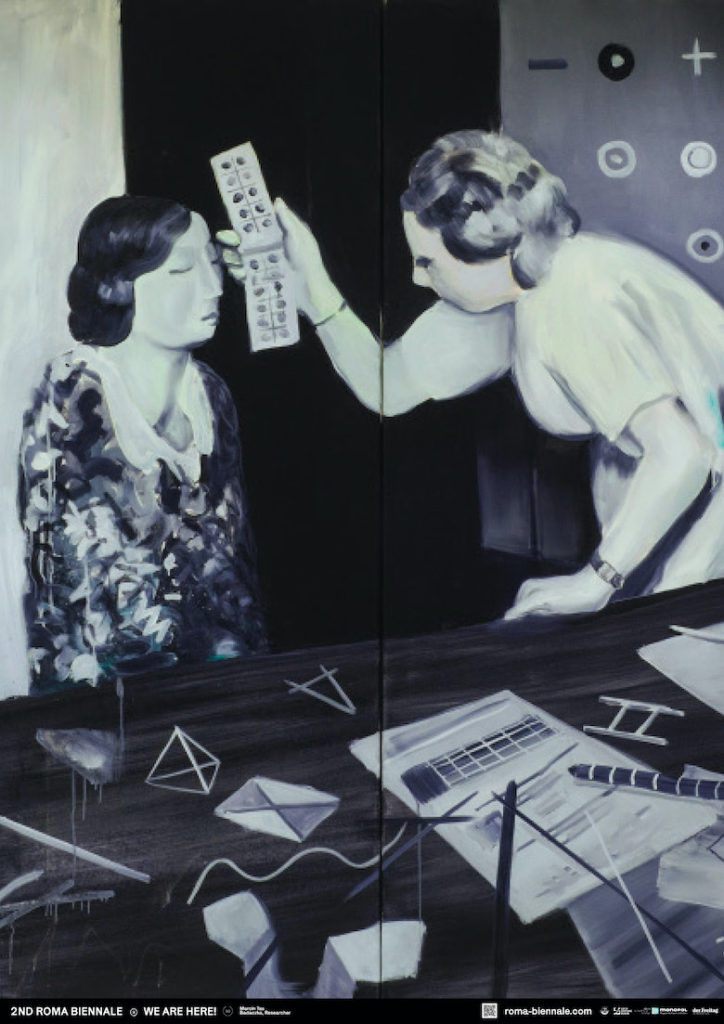We are nearing the end of this year’s edition of the Roma Biennale, an authentic art program held for the second time this year, featuring fifty international artists. The Covid-19 pandemic forced organizers to hold the Roma Biennale a year later than planned, which symbolically coincided with the 50th anniversary of the First World Romani Congress in London. From the Roma Trial platform, which aims to bring out complex anti-Roma issues to the stage, on screen and on air, through festivals, educational and political programs, creative theater and film projects, I spoke with Luna De-Rosa, a Romani artist in charge of production, communication and organization of the 2nd Roma Biennale.
Roma Trial is the initiator and leader of the first self-organized biennial of and with artists of Roma origin from across Europe, an interdisciplinary festival of art, music, discourse, and performance. What is your impression now, three years later, of this important event?
The 1st Roma Biennale COME OUT NOW! was a project by RomaTrial e.V. in cooperation with the Maxim Gorki Theater / Studio Я for the Alliance for Solidarity with the Sinti and Roma of Europe. The initiator was Damian Le Bas, one of the most important Romani artists in both history and present times. It was a tragedy that he passed away a few months before the start of the 1st Roma Biennale. The curatorial team has therefore reduced from three to two people – Delaine Le Bas and Hamze Bytyci. It was only possible to carry out the 1st Roma Biennale because of their strong commitment to the legacy of Damian Le Bas and because of the solidarity among the whole team, which was deeply inspired by him and made a huge effort to create something very special to honor him.
Due to these circumstances, the 1st Roma Biennale was a strongly touching experience and a real success for the team and the artists who participated. And it was also a milestone for Romani arts – despite of all odds, an independent biennale organized by a Romani organization and by Romani artists themselves came to life. This was very empowering, showing to the world that we don’t have to wait for an invitation to the table – we can create our own rooms which are visible and appreciated by the society we are part of. We felt that the Biennale is taken seriously, the media echo was overwhelming – the press clipping was over 100 pages long, there were articles in art magazines from Sweden and Lithuania, the German national TV ran a feature during prime-time.
Three years after the first Biennale, we have seen more responses from young Roma who have found strength in emerging and voicing their rights through the events we organize. And we have certainly opened up a window that had never been considered before, the possibility of introducing Roma and non-Roma artists from different parts of the world, who represent the realities and the diverse cultures of Romani people.
Seeing the many crises in the world, culture is more necessary than ever. For us, it represents an opportunity for self-empowerment and solidarity with all those who are not granted security and who are excluded from participation in essential resources or are even prevented from being here by deportations.
How did Covid-19 impact the realization of the 2nd Roma Biennale?
In the vision of Damian Le Bas, it doesn’t matter how big or how small the Roma Biennale is, or which form or focus it has. He had this idea of a fluid festival, which can adapt to any given conditions. The most important thing for him was to keep the continuity.
Of course, we could not have foreseen the pandemic year. So, after preparing a five-day-opening with many performances, lectures, concerts and exhibited artworks at the Maxim Gorki Theater, we had to cancel the whole program just a few weeks before it was due to start in April 2020. This was again quite a unique experience for all of us! And it was again the inspiration by Damian Le Bas showing us the way. We had to keep going and find a new form which would fit to the unpredictable and unsecure times of a global pandemic.
So in the end, the two curators Delaine Le Bas and Hamze Bytyci, with the support of the Berlin based curator and cultural manager Antje Weitzel, have chosen the form of a public space poster exhibition which is stretched over seven months and which – in times of a pandemic fills the empty walls and public spaces – under the motto WE ARE HERE!
The 2nd Roma Biennale will be presented in five chapters. Why those five chapters, what do they represent?
In five different chapters, 50 international artists explore five different aspects of BEING HERE on the occasion of five different anniversaries related to the history and current reality of Romani people.
We started with the International Romani day on April 8th, under the motto SELF-CONFESSION, in order to celebrate the 50th anniversary of the First World Romani Congress, which took place in the UK on April 8th 1971. For the first time, Roma from both Eastern and Western Europe raised their voices in the fight against Anti-gypsyism and in a common struggle for a better future. It was the breakthrough for a new political movement, with 23 representatives from nine countries taking part. The term “Roma” for “people” was accepted as a self-designation to create a new common self-awareness and to demand the recognition and respect from society. But even 50 years later, many Roma still do not openly show their identity, out of well-founded fear of discrimination and rejection in various forms: from losing a job and having less of a chance to get a flat, to verbal and physical attacks and police violence. The mere confession of oneself and one’s own identity can therefore by no means be taken for granted in 2021.
The second phase of the Roma Biennale took place on the occasion of the Resistance Day under the motto RESISTANCE & RESILIENCE on May 16th, where we remembered the uprising of Romani people in the so-called “Gypsy Family Camp” of Auschwitz-Birkenau and celebrate their strength to resist the Nazi regime – despite the seemingly hopeless conditions and exhaustion. Thanks to this unique act of resistance, many lives were saved. Even today, many Roma, Black, Muslim, queer communities and people of color, especially women, have to show courage and resilience every day to fight against the system of oppression. Especially for people who experience intersectional discrimination, the struggle for their self-determination and existence is ongoing.
On June 20th, we celebrated The World Refugee Day under the motto SURVIVAL. The World Refugee Day is an international day proclaimed by the United Nations. It celebrates the strength and courage of people who have been forced to flee their home countries to escape conflict or persecution. Romani lives have also been linked to flight and displacement for centuries. Yet in the current mainstream political discourse, Roma are denied the status of refugees, labelled as “economic refugees” and accused of deliberately abusing the welfare system. But those who come to Germany just to survive the winter and deliberately expose themselves to traumatizing deportation are not calculating cheats, but people in need, who have no chance of a dignified life in their country of origin because of racist discrimination. Being a refugee is not only about survival in the country of origin and during the flight. After arriving, refugees are exposed to exclusion and threats from the right. After the right-wing terrorist attack in Hanau (Germany) in February 2020, the question of survival after flight is becoming increasingly urgent in Germany.
The fourth phase is dedicated to the motto REMEMBRANCE and started on August 2nd. On this day, we remember the 500,000 victims of the Porajmos, the Holocaust of the European Romani people during the National Socialist era. The day refers to the murder of about 4,200 Romani people, mainly children, women and old people, in the night of the 2ndto the 3rd August 1944 in the so called “Gypsy Family Camp” at the Auschwitz-Birkenau concentration camp. But we also remember people who were subject to centuries of Anti-gypsyism and Antisemitism in Europe, and who were killed during the countless wars, during slavery, colonialism and through several genocides such as in the former Ottoman Empire, Rwanda, Namibia, Srebrenica and in many other places around the world.
The Biennale will end on October 24th, the anniversary of the inauguration of the Memorial to the Murdered Sinti and Roma of Europe, dedicated to the motto of EXISTENCE. After the end of the Second World War, it took 37 years for civil rights activists from Romani communities to obtain recognition of the genocide of the Romani people by the German government. On March 17th 1982, after countless demonstrations and even a hunger strike by Holocaust survivors and their supporters in Dachau, the then Federal Chancellor Helmut Schmidt declared: The Sinti and Roma were severely mistreated by the Nazi dictatorship. They were persecuted for racial reasons […]. These crimes constituted genocide. After another 20 years, the Memorial to the Sinti and Roma of Europe murdered under National Socialism was inaugurated in Berlin-Mitte on October 24th 2012. For many survivors and their descendants, it represents a symbolic grave that the victims never had. And for the descendants of the perpetrators, it is a memorial as well as an expression of responsibility not only for the injustice committed, but for the observance of human rights in today’s Europe. But for the German state, all this seems to be only half as important. For several months, negotiations have been ongoing about how much this place may be damaged because of the construction of a city train line. The question is being asked, are representatives of the Berlin government, the German Parliament and the German Railways – the successor organization to the Reichsbahn, which made a profit with transports to the concentration camps – taking back their declared responsibility for the genocide? In any case, they are deliberately ignoring the voices of the survivors. And they ignore all those whose existence is affected by an intervention in the memorial. The monument bears witness to our history, and stands symbolically for hundreds of thousands of our ancestors whose lives were extinguished. There is often nothing more than our memory and this Memorial. The Memorial bears witness to the existence of our ancestors and thus also to our present reality.

romani Resistance_Ludovic Versace for La voix des Rroms 
Marcin_Tas_Badaczka_ 
Mara Lea Hohn
How many artists will have the opportunity to present their work at the 2nd Roma Biennale? What was the ratio of male to female artists who were exhibiting their artworks back then in 2018 and what is the situation this year?
Thanks to the flexible form of the 2nd Roma Biennale, we are able to present 50 international artists, most of them Romani, but also artists of color and artists from other racialized and marginalized communities, both men and women, from established artists such as Małgorzata Mirga-Tas to young artists at the beginning of their careers such as Jeffrey Wynne. Many of them are women: Selma Selman, Nathalie Anguezomo Mba Bikoro, Valery Leray, Małgorzata Mirga-Tas, Riah Knight, Barby Asante, Moshtari Hilal, Marina Rosselle, Iva Bittova, Emilia Rigova etc. who, through their own language, from performance to music to painting and drawing strive to construct an affirmative, situated iconography of a Roma community from their feministic perspective. For the catalogue, which will be produced at the end of the Biennale, most of the contributors we would like to involve are female – e.g. Ethel Brook, Jo Clement or Nicoleta Bitu.
In comparison to the 1st Roma Biennale, there are many more artists involved. In 2018, performance artists were mostly involved in the centerpiece called “Long Night of Coming-Out”, a collectively developed performance night by and with 13 artists, half of them were female: Candis Nergaard, Damian James Le Bas, Delaine Le Bas, Franciska Farkas, Hamze Bytyci, Kristóf Horváth, László Farkas, Lindy Larsson, Mihaela Drăgan, Mihails Kokarevics, Riah Knight, Sandra Selimović and Simonida Selimović. There were also other artists participating in other events during the 1st Roma Biennale, e.g. the Berlin based comedian Idil Baydar or the artist Tucké Royal who were both part of the performance Hilton 437.
If we focus only on Romani women here, we can say that through history they were portrayed very differently – promiscuous and free, and at the same time trapped by their own traditional culture. How important is it that Roma women produce the art but at the same time work with prejudices and stereotypes in order to disapprove them?
It is crucially important that Roma women are finally being seen with their true biographies and identities! The dominant public image of Romnja is strongly influenced by anti-gypsist, sexist and classicist stereotypes, they have to face intersectional discrimination. Images of independent, self-confident and successful Romani women are desperately missing in the mainstream culture, ideas of queer identities and non-binary bodies are not present at all. Recent studies from Germany (e.g. by Elizabeta Jonuz and Jane Weiß) show that it is often Romani women who make the educational breakthrough in their families – and that their families are their greatest support and strongest resource.
Of course, there are also Romani women who have a double claim to make: Due to Anti-gypsyism and due to patriarchal and therefore male chauvinist structures. But we have to break the centuries-old colonial idea, that patriarchy is part of the “Roma culture”. Patriarchy is part of all cultures and societies!
This is the ideas, our work is based in. From this perspective, presenting successful Romani artists is a huge step – and the question of dealing with prejudices and stereotypes in the artistic practice seems to be subordinate. It should be a personal choice of every artist if she or he wants to address anti-gypsyism in her or his work.
Would it be possible to find some similarities among the artworks of Romani women when it is about their womanhood and how they see themselves?
In many Roma artists the body is certainly an important issue, many of them work in the field of performance and connect the body with the social context that governs and essentially defines it, in this case that of a women and enact an inter-scalar approach to the collective self-emancipation of oppressed women. Topics such as those on issues of identity, race, gender, sexuality, and the continuing violence and exclusion against those perceived as “the other” in society are very important, for example in the works of Delaine Le Bas, as well as Valérie Leray’s photographs, focuses on two areas of exploration, portraits (identity), and places (memory). What drives Leray, in an ethical way, is to try to find the identity beneath the category, just as the question of memory is inscribed in the apprehension of places.
Even today, many Roma, Black, Muslim, People of Color, especially women, have to show courage and resilience every day to fight against systems of oppression. We see that women, especially those coming from minority groups, gather around the world, speak up and raise awareness, but at the same time, there is the issue of widespread police brutality against the Roma.
In recent years, episodes of racism and xenophobic attacks have worryingly increased. Immigration and racism have certainly been a substantial part of the electoral campaign in many European countries. We have witnessed a general moment of attacks and threats against immigrants, refugees, minorities. Discrimination, in all its possible forms and expressions, is one of the most common forms of human rights violation and abuse. Discrimination renders people powerless, prevents them from becoming active citizens, limits the development of their capacities and, in many situations, their access to employment, health services, education or housing. While all women are affected by inequalities in a range of areas, Roma women face additional challenges as poverty, exclusion and discrimination in some cases further reinforce their disadvantages in core areas of life, such as education, employment and health.
What we have to realize is: The racist, sexist and classist oppression is part of the nowadays structures and social systems – police violence towards Roma and other racialized people is happening all over Europe and only very rarely do those affected and their relatives experience justice. The states and their systems are not interested in investigating racist misconduct of police officers and other authorities. And unfortunately, even the EU doesn’t use the tools it has to push it’s state members to do so.
This means for us that we have to organize ourselves both across communities and across countries and we have to demand a radical, systematic change. Art offers a rich intellectual starting point, it can disrupt existing images and create new utopias. Art is free of boundaries, art is a real chance to decolonize our minds. This is crucially important for the future of our children: They have to liberate themselves from the white gaze, from the oppressive system and start to be feeling as part of an ancient and rich cultures that is Romani.












